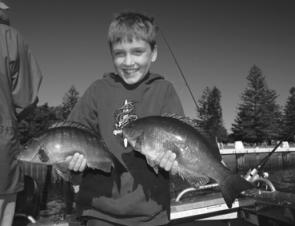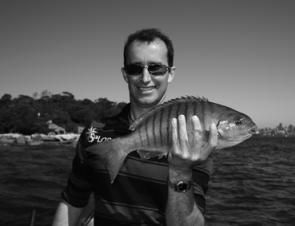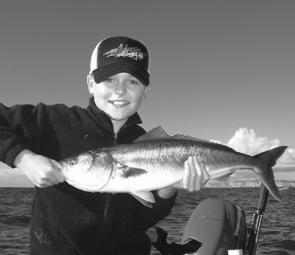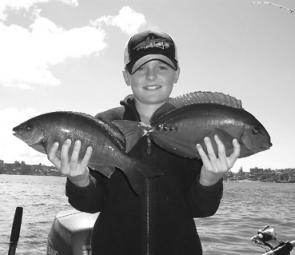Summer seems to have come early this year with some scorching hot days and unseasonably warm water. As a result, the fishing has been sensational with all the Winter fish sparking up and some of the Summer fish kicking in early.
Salmon have been thick around the Heads, venturing in as far as Manly wharf at times and under them have been bonito, tailor and even the occasional kingfish. Bonito and tailor feeding on the surface is something that we would normally not expect to see til November.
The bream have started to bite and flatties have been nailing plastics bounced along the bottom at Balmoral, North Harbour and Rose Bay. The only downside is that the action has been erratic, with crazy, bubbling schools one day and nothing the next, but this situation will improve as it warms up further.
Fortunately the most reliable of all the Harbour’s fish, the blackfish, have filled in the gaps when all else goes quiet. Top spots have been Fairlight Point, Clontarf, Bottle and Glass and Sow and Pigs. A few surgeon fish have been mixed with them so it might be a good idea to up-class your tackle a bit.
Luderick are still quite prolific, having survived the ravages of commercial fishing and pollution a lot better than most other species. They fight well, are great to eat and are found through a range of habitats that includes the most tranquil estuarine reaches to harsh ocean rocks. They are well within reach of shore-based anglers, inexpensive to set up for and are a year-round proposition.
Luderick do require specific techniques that can take a considerable time to learn but, once they are mastered, the fish flow freely.
Here's a bit of information on tackling up for blackfish that might help short cut the initial learning curve.
The tricky bit to blackfish is in the control of the rig. Light floats, long drops, wind-resistant baits and lots of sinkers add up to a rig that demands constant attention. There are two ways to go and they both have their good and bad points.
You can opt for the running float rig comprising a standard, long-stemmed blackfish float that is free to run on the line. It's stopped a certain distance from the hook by a split shot and stopped from running all the way up the line by a ‘stopper’ that can be a piece of light string tied to the line or any one of a number of commercially-produced rubber stoppers.
The main criterion for a stopper is that it clamps tightly enough to the main line to stop the float sliding any further than you want it to, but still must be loose enough that it can be moved up or down to change the depth of the drop. It must also be able to be wound through the runners, sometimes even onto the reel and cast back out again without snagging.
The main advantages of this rig are that the length of the drop from the rod tip can be as short as 60cm and the maximum depth of the drop below the float is infinite. This makes it an easy rig to cast and can be cast further than the alternative.
The disadvantage is that it is prone to tangling due to the wind-resistant bait being very close to the float during the cast. Its common with this rig for the line and bait to tangle around the float.
The alternative rig consists of a fixed float. A split shot clamped above and below the float restricts its movement up or down the line. This means that the float is fixed on the line at the full depth you are fishing. The problem with this rig is that if you are fishing deep, let’s say 3m or more, you will have that full 3m of line hanging down from the rod tip. As you would imagine, this would be difficult to handle.
The big advantage with this rig is that is much less prone to tangling during the cast because the bait is so far from the float. This is the method I use most often. Obviously, if you are fishing more than about 4m then this rig is not applicable, but this does not occur very often.
Weighting of the float is critical. Most floats consist of a thin stem with a streamlined float of cork or foam about two-thirds of the way up the stem. The float must be weighted so that the cork or foam section is under water, leaving just the one-third of the stem above the float showing.
The float is weighted with split shot, running sinkers, strip lead around the stem of the float or a combination of all of these.
Weather conditions dictate the size and weight of the float you will use. In windy, rough conditions you will need a big, heavy float and in calm conditions, the smaller the float the better. A quill float makes an ideal still-water float.
Rods used for blackfish are long and soft for a number of reasons. They are long because of the need to handle the long drop often used under the float, as described above. The extra length also helps to lift the belly out of the line when you go to strike. Belly refers is the arc in the line between the rod tip and the float, often created by a cross current or wind.
On a long drift, the belly can become so severe that the strike serves only to lift out the belly and sometimes never reaches the float. The rod must be soft because the blackfish's mouth and the hooks used are small. Combined with a stiff rod, this would pull the hook clean out of the fish’s mouth. The long rod offers the cushion needed to prevent this happening during the blackfish’s strong lunges.
The choice of reel is up to you. I’ve seen egg-beaters, baitcasters and centrepins used successfully. Centrepins are still used on a traditional basis rather than on their practicality. If you opt for a centrepin then go for a sidecast model such as those made by Alvey.
I use threadlines because they offer open-face casting, a fast retrieve important when picking up belly before striking and the ability to feed line smoothly to the float to allow it to drift.
For the smaller river blackfish a 6lb line and a No 8 or No 10 hook will suffice. The big ocean bronzies will require heavier tackle. A No 6 hook would be more appropriate along with 10lb or 12lb line.
Gelspun lines are credited for their non-stretch properties. There are situations when low stretch is good but not when blackfishing. Non-stretch lines do have a reputation for tearing hooks out of fish, a problem already prevalent with blackfish.
A compensation is the fact that gelspun lines float. This is a huge advantage when picking up belly as it is much easier to pick up a line off the surface than line that has sunk, as monofilament lines do unless they are waxed or dressed to float. Gelspun line makes an excellent blackfish line in experienced hands holding soft rods.
Reads: 1361
Harbour luderick are still quite prolific, having survived the ravages of commercial fishing and pollution a lot better than most other species.

The tricky bit to blackfish is in the control of the rig. Light floats, long drops, wind-resistant baits and lots of sinkers add up to a rig that demands constant attention.

Salmon have been thick around the Heads, venturing in as far as Manly wharf at times and under them have been bonito, tailor and even the occasional kingfish.

A few surgeon fish have been mixed with the blackfish so it might be a good idea to up-class your tackle a bit.




